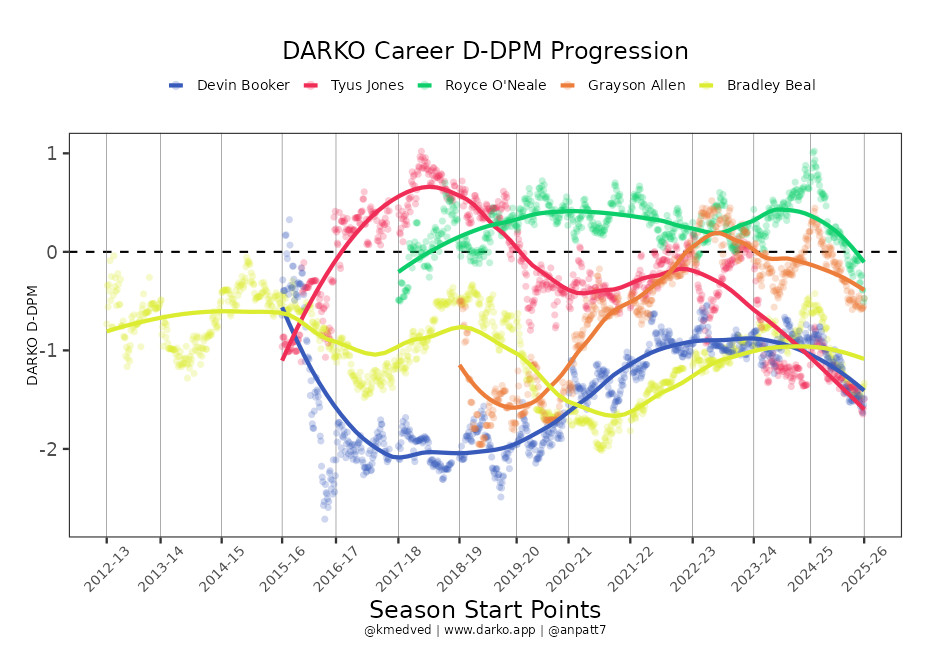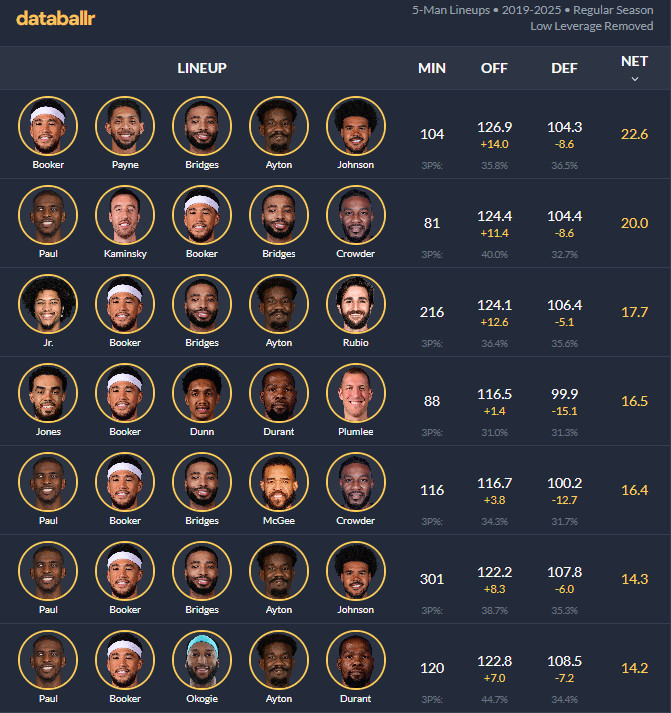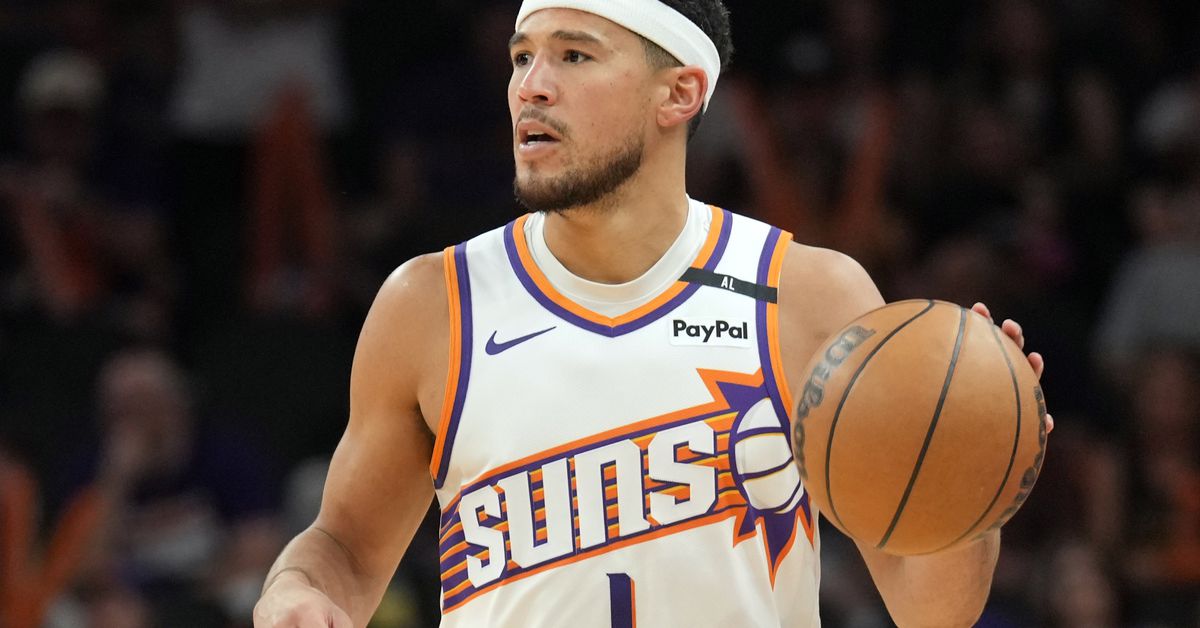Devin Booker is clearly the guy the Phoenix Suns have invested their future in, and that’s completely logical. He’s proven, he has undeniable talent, and the fans love the guy. The next step is building that championship core around him.
If the Suns want to extract the absolute maximum out of their star, they have to give him the support he needs on both ends of the floor. Last season was a down year for Booker, particularly defensively, but I’m happy to chalk that up to the system and the lack of a full summer to prepare. Ironically, the Olympics showed how effective Booker can actually be on defense.
All of the team’s perimeter defenders suffered last year, though, which leads me to believe it was more of a coaching issue than anything.

Perimeter defenders on the Phoenix Suns last season
www.darko.app
In the graph above, you will see the use of DPM (DARKO Plus-Minus), and this will crop up again later on. For anyone who has never come across DPM, it is just one of those all-in-one advanced statistics that take into account all kinds of quantifiable things. Like all statistics, it is not perfect, but it is one of the best indicators for player performance we have at the moment. Generally, DPM covers both the offensive and defensive contributions, but it can be further split into O-DPM and D-DPM if you want to take a look at them separately (like above).
Many different coaches and players have been employed to varying degrees of success over the past few years in Phoenix, but the key question is, what would the perfect team around Booker look like, and how do we get there? I looked into the performance of past Suns lineups to try to build a team of player archetypes they can aim for in the coming years.
Over the past five or so years, the Suns have had some great five-man lineups and some disastrous ones. Looking at those with the highest net ratings, we can start to see some patterns.

Suns top 5-man net ratings
www.databallr.com
We are less confident in the net rating of the lineups with fewer minutes, hence the introduction of a minimum 70-minute cutoff.
Now, if we want to look at purely fit, and not just overall performance (heavily reliant on player quality), then we must account for the talent in the lineup. I have chosen to do this by summing the individual DPM scores for each player in the 5 and then subtracting this from the lineup’s net rating, in order to get a true “synergy” value for each. Lineups with high synergy are examples of teams that can perform to a level that is more than just the sum of their parts.
We will look at the top 4 lineups ranked by synergy below:
1. Tyus Jones – Devin Booker – Ryan Dunn – Kevin Durant – Mason Plumlee (15.6 Synergy in 88 MIN):
This may come as a shock (it certainly did to me), but this lineup from last year was actually incredibly successful in the 88 minutes they were on the court together, primarily driven by their superb defense. Dunn’s point of attack defending, combined with Plumlee’s rim defense and Jones’ low turnover possessions, led to a defensive rating of 99.9 (for reference, OKC’s DEFRTG for the season was 105.7). On the offensive side, surrounding two juggernauts with a facilitating point guard and two low-usage players seemed to be a framework that worked.
2. Cameron Payne – Devin Booker – Mikal Bridges – Cameron Johnson – Deandre Ayton (15.25 Synergy in 104 MIN):
Cam Payne’s ability to push the pace caused this lineup to boast an astonishing offensive rating of 126.9. This, combined with floor-spacing two-way wings, allowed for this young side to perform way above expectations when on the court together. Upping the pace is something new coach Jordan Ott has spoken about in his press conferences, and this right here is evidence that it could benefit Devin Booker.
3. Ricky Rubio – Devin Booker – Mikal Bridges – Kelly Oubre Jr. – Deandre Ayton (11.2 Synergy in 216 MIN):
This consistent lineup from the 2019-20 season, marking Deandre Ayton’s sophomore year, signaled the dawn of a new era for the Suns. Its strong 11.2 synergy over a significant 216 minutes reinforces a developing pattern: the profound value of a pass-first point guard like Rubio. His presence allowed Booker to operate more effectively as an off-ball scorer and a primary finisher. Combine this with crucial floor spacing, strong team defense and you have a formula for success.
4. Chris Paul – Devin Booker – Mikal Bridges – Jae Crowder – Frank Kaminsky (10.7 Synergy in 81 MIN):
While Paul, Bridges, and Johnson consistently formed a strong core around Booker, Kaminsky’s presence here indicates that a floor-spacing center can also be a good fit, pulling opposing bigs out of the paint and creating driving lanes for Booker.
Let’s look at one more notable lineup:
Chris Paul – Devin Booker – Mikal Bridges – Jae Crowder – Deandre Ayton (-5.95 Synergy in 1364 MIN):
The most played lineup of the last 5 years. Now, I am by no means saying this lineup was bad, but the data shows that they may have underperformed given the talent there.
A collective DPM of 12.95 only generated a net rating of 7. A key factor was likely the offensive drop-off when replacing a player like Cameron Johnson (who excelled at catch-and-shoot threes and off-ball movement) with Jae Crowder in a similar role. While Crowder is a valuable 3-and-D player, his streaky shooting and more limited ability in transition when compared to dynamic wings like Kelly Oubre Jr. meant the offensive system may not have panned out with the same efficiency.
Crowder, in this specific offensive role, was often limited and unable to be as effective as Johnson, thereby capping his offensive contributions. This, along with his suboptimal fit in the frontcourt with Ayton, could be reasons why this lineup may have failed to equal the sum of its parts.
The Blueprint
Point Guard: The Low-Usage, Pass-First Facilitator / Defensive Catalyst
The analysis shows the monumental impact a point guard who prioritises playmaking and robust defense can have. Whether it was Tyus Jones’ low turnovers, Cam Payne’s pace-pushing, or Ricky Rubio/Chris Paul’s pass-first approaches, the pattern is clear. In order to extract the maximum from Booker, liberating him of playmaking duties so he can thrive as an off-ball scorer, this archetype is necessary.
Small Forward: The Elite Defensive Disruptor
Looking at high-synergy past lineups, it is clear that a defensive small forward who can also space the floor is pivotal. Mikal Bridges was the prime example of this during his time on the Suns and was a great success. We have also seen Ryan Dunn be effective as a low-usage athletic defender; it is clear to see why there are high hopes that he can become an elite role player in the future. This guy is likely going to be guarding the opposition’s most dangerous perimeter threats, so strong point-of-attack defense is crucial. Someone who can cause chaos on this end of the floor and allow Booker to conserve energy would be the perfect fit.
Power Forward: The Versatile Two-Way Forward
The ideal power forward in a Devin Booker-centric lineup is a player who provides crucial floor spacing with reliable three-point shooting, offers defensive versatility (especially in switching schemes), and contributes to rebounding, all without demanding significant offensive usage. Players like Cam Johnson and, at times, Jae Crowder, have been deployed here with their perimeter shooting being key to opening up driving lanes for Booker. This archetype bridges the gap between the defensive wings and the interior presence, contributing on both ends without being a focal point.
Center: The Complementary Big
This is the one position that we can be a bit more flexible with. Our research has shown that various styles of centers have had strong fits with Booker in Phoenix. If there was enough floor spacing across the lineup already, then a defensive anchor who could provide vertical spacing may be the best fit. Think of a rim-protecting roll-man who could finish lobs for easy points. Players like Deandre Ayton, Mason Plumlee and Javale McGee have all had periods of success in this role alongside Booker.
If there was a lack of floor spacing on the team, then this is where having a center who could stretch the floor would be valuable. You may sacrifice some defense here, but successful lineups containing Frank Kaminsky showed that it’s possible to maintain a strong defense while reaping the benefits on offense.
Current Roster Alignment
In terms of the current roster, the strongest fits are:
Devin Booker (in the role of…Devin Booker)
Collin Gillespie (Low Usage Pass-First Facilitator)
Dillon Brooks (Defensive Disruptor)
Ryan Dunn (Defensive Disruptor)
Royce O’Neale (Versatile Two-Way Forward)
Rasheer Fleming (Versatile Two-Way Forward)
Mark Williams (Defensive Anchor/Roll-Man)
Khaman Maluach (Defensive Anchor/Roll-Man)
Oso Ighodaro (Defensive Anchor/Roll-Man)
That’s a strong base; there are definitely some pieces to work with here.
If the Suns invest in the development of their center rotation whilst continuing to focus on Ryan Dunn’s 3PT shot, there is potential here to be competing in 3-4 years. The big talking point is what happens with Jalen Green. Having your second-highest-paid player play out of position at point guard is suboptimal, and if the Suns want to become competitive again, they need to maximize all of the few assets that they have. He is not the archetype we want in the backcourt with Booker. I’m sure there will be some experimenting with the two, though.
Even though Booker’s playmaking has improved a lot over the years, I’m not fully convinced this is the best way to maximise him. Maybe the goal is to win games next season, though, not build a long-term contender from the ground up. If they want to accelerate the timeline on building a contender, they need to build up Green’s trade value and capitalise on that, strengthening the team in areas of need (PG and PF).
If we are being realistic, the Suns have to position themselves to be competing back at the top of the Western Conference by 2028-29. They simply do not have the roster or the assets to get there any sooner.
So when looking at that timeline, players like Dunn, Fleming, Maluach, and Ighodaro will have settled into the league, and we will be able to confidently assess their level. Players like Mark Williams and Collin Gillespie will be entering their primes (if they are kept around that long). There are promising signs that these players can develop into strong fits for what is needed; the remaining assets need to be converted into a starting-level point guard and power forward. Players like Dillon Brooks and Royce O’Neale may be decent fits now, but they do not exactly fit our timeline. If any opportunistic moves are available to be made, they should not be off the table (and neither should Green).
Potential Future Fits
Point Guard
Ambitious: Dyson Daniels
We are effectively looking for a younger Jrue Holiday-type player. 2025 DPOY contender Dyson Daniels fits the mould perfectly with his elite defensive tools and strong playmaking foundations. Atlanta are unlikely to let him leave easily given his fit with Trae Young in the backcourt there, but if there is any sort of reshuffling there he should be the prime target.
Feasible: Andrew Nembhard
Nembhard is already a proven high-IQ, low-turnover guard who consistently reads the court well and makes good decisions. He would be firmly entering his prime by the time we want to be competing and he embodies the low-usage defensive catalyst we are looking for at the point guard spot. He may be a more feasible acquisition compared to Daniels given his lower scoring averages, limited athletic upside and playmaking overlap with Pacers star Tyrese Haliburton. If they wanted to pivot in the direction of more a standard scorer at the 2 (interested in Jalen Green?), he could become a trade target for the Suns.
Power Forward
Ambitious: Keegan Murray
Murray is a near-perfect embodiment of the “versatile two-way forward”. He’s an elite catch-and-shoot three-point shooter (career 37.2% from three), providing essential floor spacing. Defensively, he’s a disciplined and versatile defender who can guard multiple forward spots and contribute on the glass. He excels in a low-usage, off-ball role, making him highly complementary to a star like Booker. Murray is one of the Kings’ few valuable assets, so it would be very tough to pry him away. The only hope would be that they may want to sell high if they are looking to enter a full rebuild.
Feasible: Obi Toppin
Toppin brings elite athleticism, exceptional transition play, and strong vertical spacing as a lob threat and cutter. Crucially, his three-point shooting has steadily improved over the last couple of years, making him a viable floor spacer. Defensively, his athleticism allows for versatility in switches and high-energy contests. He would be much less costly than Keegan Murray, given the lower ceiling and the Pacers’ depth in his position. They have Pascal Siakam starting at the 4, which looks unlikely to change any time soon, and Jarace Walker waiting in the wings as a young talent ready to take a step up (could also be an option for the Suns; however, the price would likely be similar to that of Murray). If Toppin wanted more minutes and a larger role, Phoenix could be a destination for him.
What our future contending Suns could look like:
Andrew Nembhard – Devin Booker – Ryan Dunn – Keegan Murray – Khaman Maluach
Keeping Mark Williams and Collin Gillespie would be strong depth around these guys, and any remaining assets can be used to go all-in during the last years of Booker’s prime and fill out the roster. Supporting Devin Booker with playmaking and strong defense is the key to unlocking his scoring potential once again, and if all of these things come together, the Phoenix Suns could once again challenge for a ring. Booker’s brilliance is the Suns’ foundation, but true championship contention demands strategic team construction.
History tells us individual talent isn’t enough; fit creates additional value, while misfits can diminish it. The Suns must build up value through internal developement of talent and successful coaching.
To accelerate contention, the Suns must be aggressive and intelligent in asset management. This means strategically pursuing their ideal archetypes like a starting point guard and a long-term power forward while potentially leveraging current assets that don’t align with the future vision. The path to a championship isn’t through splashing the cash and attempting shortcuts, but by building a cohesive side around Devin Booker and developing a strong culture along the way.

